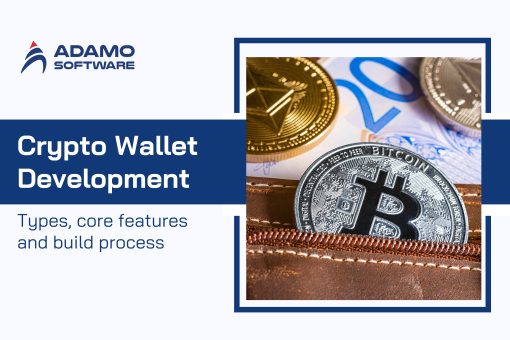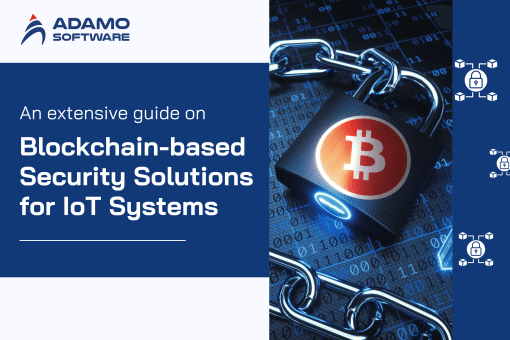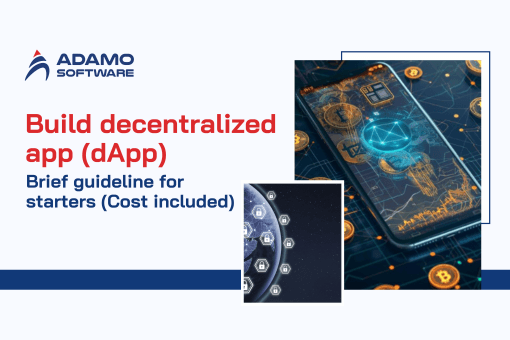How to develop a blockchain application: An 8-Step Comprehensive Guide

Blockchain is not something new to many of us today. It has been one of the most critical technologies that changed our lives in the past few years. By now, you must’ve heard of it thousands of times over. However, there was a time when only those who invested in cryptocurrency knew about the term. After all, this tech was initially developed for cryptocurrency transactions like Bitcoin.
Over time, blockchain became more popular, and more attention is given to how to develop a blockchain application. These trends owe a big part to blockchain’s secure nature. Understanding how to develop a blockchain application will undoubtedly help you build a far more transparent, private, and speedy app than traditional centralized ones.
However, many people still don’t know how to develop a blockchain application as it’s quite an intricate process and requires deep technical knowledge. Also for this reason, only a small number of developers are capable of creating these kinds of apps.
But wait, don’t be discouraged just yet. We’re here to help! This article will focus on the question of how to develop a blockchain application. We’ll cover everything from the basics to detailed steps on how to develop a blockchain application. Let’s dive in!
I. How to develop a blockchain application: What is it?
To know how to develop a blockchain application, we must understand the technology.
A blockchain application, or decentralized application (dApp), is an application that is based on blockchain technology. It incorporates shared and distributed databases to enhance data security and offer an environment through which transactions can be performed. Compared to conventional centralized apps with information stored on one or more servers, blockchain apps are distributed across several devices. This makes them more secure, transparent, and resistant to censorship.
It serves diverse uses, including (but not limited to) digital identity, supply chain, and cryptocurrencies such as Bitcoin and Ethereum. In these apps, information is saved in “blocks,” which link to form a chain by being consistent with the previous or next block. Therefore, whenever a transaction is made, all members of the network will know. This really helps make the process more transparent and more accessible for verification.
To understand why it’s important to know how to develop a blockchain application, let’s look at the rapid expansion of this market. Specifically, the blockchain technology market was $10.2 billion in 2022 and will grow at 87.7% CAGR for 2023-2030. This growth is fueled by the benefits of the blockchain system over the traditional system, such as enhanced security and decentralized control.
II. How does blockchain technology work?
Before moving on to details on how to develop a blockchain application, let’s first try to understand how this tech works.
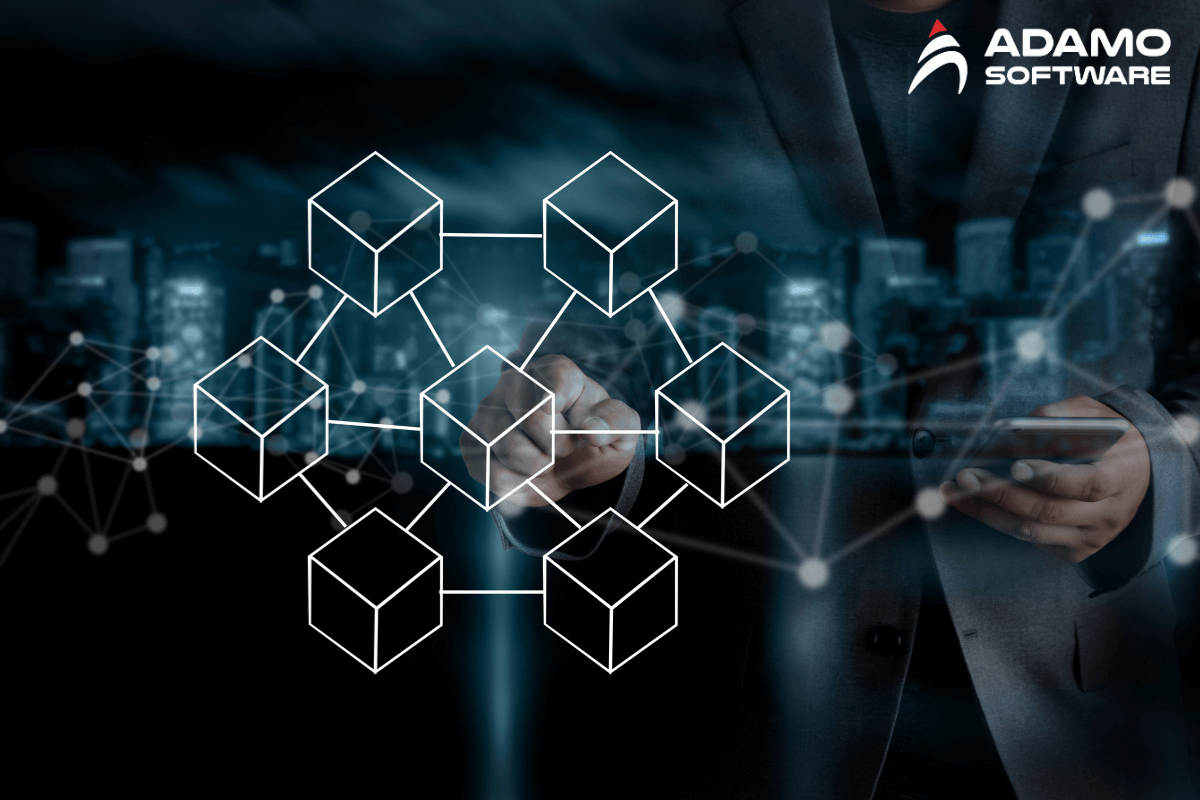
As mentioned above, blockchain is a distributed ledger of transactions, and it stores pieces of data grouped in blocks. A block is closed and connected to the previous block when it is complete. Therefore, it creates a chain rather than a linear list. Once these blocks are added to the chain, they cannot be altered or edited. This is what provides the blockchain with the security it is known for. After that, new data will be created in a new block that is added when more information is received.
Also, data stored in the blockchains are accessible by every network member, allowing for universal availability, transparency, and security. For instance, a company needs help managing data sharing and collaboration on some projects. In this case, everyone can receive data through the blockchain app and check the data’s correctness.
It is like a Google document you work on collaboratively with your team members. Every person working on the document may open the document simultaneously, and any changes are evident and are made instantly. This way, every time a transaction is made, data about the transaction is reflected in all member’s blockchains.
III. How to develop a blockchain application in 8 steps
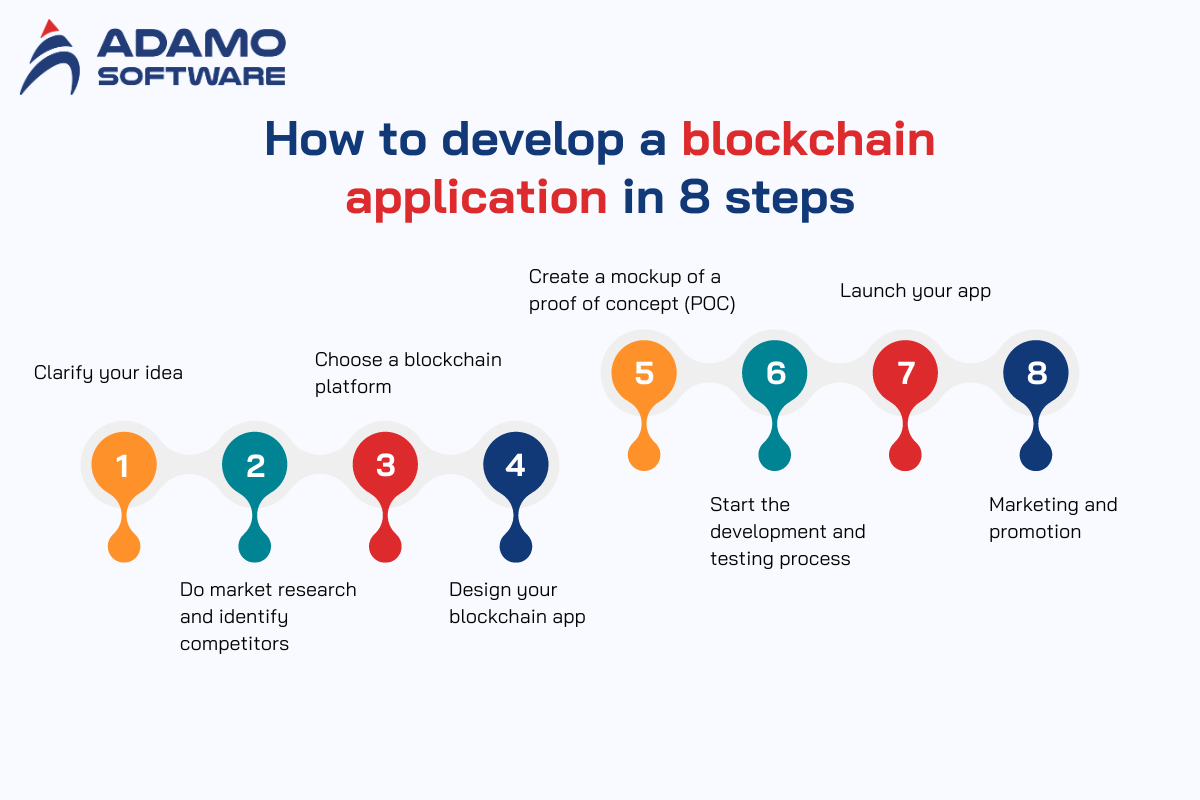
1. Clarify your idea
A crucial element to notice when learning how to develop a blockchain application is the idea. Having a vision of what you want to do before you start is always helpful. Even though blockchain exists, only some businesses or tasks need it. Furthermore, many issues need less complex and operational solutions. This means it is wise to reassess if the blockchain solution appropriately addresses a problem.
Start by outlining the particular issues or challenges that you need to address. Ask yourself: for these problems, how to develop a blockchain application that delivers real value? For example, does your project require increased security, decentralized systems, or the ability to open communications and show information? Blockchain, as we know it, is well adapted to linked features such as secure data storage, transparent transactions, or decentralized control.
Once you follow through this process and have chosen how to develop a blockchain application as the perfect solution, it’s time for idea conceptualization. This involves setting out objectives and desired employees and describing activities the decentralized application offers. You also must identify how the application will work within the realm of blockchain. For instance, which blockchain network will be best, and which smart contracts would be necessary?
Understanding these aspects of how to develop a blockchain application is essential early on. You’ll know whether your idea can be developed and if it has the potential to be developed for the market.
2. Do market research and identify competitors
The next step in how to develop a blockchain application is market research and competitor identification. Whether you’re developing a new blockchain app for your company or introducing a fresh product, it is essential to know your competitors.
First, learn the steps other businesses within your industry are taking to implement blockchain. Are there similar ideas that solve your problems using blockchain? What are those features, and how well are they performing? Doing this will help you discover the most critical factors to help your app thrive. Those are the niches still needing to be filled, distinctive features that can be marketed, or ways you may enhance the current solutions in the market.
When finding out more about your competitors, an excellent route is to research their social media profiles. Popular platforms like LinkedIn, Facebook, and Twitter can illuminate their blockchain visions. Check, for instance, how they design the submission of their applications or what their customers say about them. You can even see how much the followers care about blockchain solutions. LinkedIn is ideal for engaging with other professionals and watching how your competitors position their blockchain products.
Understanding what options are available will help you know what works and what doesn’t. It also gives you a glimpse of what you can do better or differently. It will guide you in how to develop a blockchain application, ensuring your project is ahead of the competition.
3. Choose a blockchain platform
The way you approach how to develop a blockchain application should serve the purpose of your business. To choose the appropriate platform, evaluate blockchain features, the consensus mechanisms, and the issues you would like to consider for users. For instance, you can create a decentralized public application program with smart contracts from the Ethereum blockchain.
There are two ways to approach this:
- Create a new blockchain: Designing a new blockchain architecture means having your unique transaction validation procedures, algorithms, technological set, fee, etc. This is the most flexible for blockchain platform development, but it will be time-consuming and costly. You should only take this road if you are considering launching your cryptocurrency.
- Clone an existing blockchain platform: Another way to develop a blockchain application is using an open-source platform whose source code can be hosted on your server. This ensures that users can still receive your app users receive.
So, you can create a blockchain framework from scratch or use one of the existing blockchain platforms. You may also get a white-label system from blockchain as a Service and use outside cloud services.
Ultimately, your choice depends on the issues you want to address, and which environment suits you best with the available features. That means assessing the current consensus mechanism, its capacity, its range of capabilities, and the level of use are what you need to do.
The general construction of your blockchain is a time-consuming and costly process. However, it would help if you remembered that there are open-source platforms available to you, and you can use their code. These include:
- Ethereum: This one is based on the Solidity programming language and is very popular, only after Bitcoin. It is meant to be conveniently programmable, making Ethereum also host dApps, smart contracts, and most NFTs (non-fungible tokens).
- Hyperledger Fabric: This platform is perfect for use in a corporate context, such as when exchanging information with corporate members.
- R3 Corda: Ideal for eCommerce applications, healthcare, and supply chains. R3 Corda is a platform to build permissioned blockchains.
4. Design your blockchain app
Next on how to develop a blockchain application is to create “the look” of the app to look great and operate well. This phase, generally called UI/UX design, is often where the idea is visualized. Regardless of the complexity on the development side, the app’s design needs to be simple and easy to navigate to succeed.
Collaborate with specialized designers to design an easy-to-understand and manageable interface. This is where user experience (UX) designers become essential as they plot the course the user is likely to take. They aim to help maintain a smooth flow of the app’s user experience, ensuring they can do what they want. Simple is the new way to go, no matter the purpose – handling transactions, sharing data, or executing smart contracts.
Knowing that good UI will improve the app’s usability and user’s adoption, and satisfaction is essential. The users will not likely use complex, less friendly, and less graphically appealing blockchain applications. The design used also assists in getting clarity, which enhances usability for those with no background knowledge about blockchain.
All in all, good UI/UX design plays a crucial role in how to develop a blockchain application. Following user needs and making the process easier will increase user attraction and active user rate.
5. Create a mockup of a proof of concept (POC)
It would be ideal to have a mockup or proof of concept to illustrate and show how the blockchain app will work. This can often be a theoretical build-up or a model in how to develop a blockchain application.
Theoretical build-up calls for use case scenarios that assist the stakeholders in appreciating the feasibility of the product. The app prototype, which is created based on feedback, will include:
- Design sketches
- Tested product
- Mockups
- Information architecture
Having a prototype to test all the features before going live is especially important when learning how to develop a blockchain application. This will assist you in prototyping your idea and consider the players’ roles in the network. It also helps to see the transactions that they will be conducting, as well as their relationship on the blockchain.
Additionally, in how to develop a blockchain application, you must define which app features will be on the blockchain, and which are not. Indeed, not all features you may need in your mobile or web application need blockchain. Instead, they can use cloud hosting. You will also, therefore, need to choose between permissionless or permissioned blockchains.
Azure Blockchain Workbench has relatively easy steps to create if you want to develop a simple prototype blockchain app.
After the stakeholders approve your proof-of-concept or prototype, it is time to check the technical and visuals.
6. Start the development and testing process
What you should understand about how to develop a blockchain application is that, given specific parameters, the process will look completely different:
- Which dialect and system will you use in your project?
- How do you decide how a decision will be made?
- The process through which all nodes engage and communicate, and all nodes transact.
Other than these aspects, the development will depend on what you do with an existing blockchain, whether you use a BaaS or build your blockchain.
In other words, the transition must be smooth. Also, the designers and the developers should be able to sort out minor details before coding occurs. After that, the coding is complete. Before the deployment, the QA engineer performs a regression test to ensure everything comes out perfectly.
It is also important to conform to the set terms and conditions of the App Store or Google Play Store to thrive. Additionally, a comparison of the results and the data user analysis should be performed after the completion of the deployment procedure.
7. Launch your app
The seventh step in how to develop a blockchain application is to launch your blockchain app. When you’re done with your test suite and squashed all the bugs you discover, it’s time to roll out. However, remember that app launching is only the beginning and not the last step of the process.
Once the app is out for public use, it becomes essential to monitor it constantly. You will have to assess its effectiveness and look at crucial parameters. These can include user interactions, the number of transactions made, and problems users face. This information will allow you to see how your app performs in the real world.
User feedback should also be monitored because it will provide information on other things that need enhancement. Regular updates, therefore, are crucial in ensuring the optimum functioning of your blockchain application in line with the user’s expectations. They will address all the issues that may arise from software application bugs, changes in UI, or adding new features.
Remember: Launching is only the beginning of the app’s life cycle. Being more proactive with the performance analysis and amending will keep the blockchain application stable and relevant to users and technology innovations.
8. Marketing and promotion
The last step in how to develop a blockchain application is no other than marketing and promotion. While building the app itself is a huge deal, attracting and retaining users is no less essential. Even when your app is highly functional, if not promoted well, it will not get the success you’d expect.
Some companies start marketing their products way before starting their journey on how to develop a blockchain application. By doing this, they always have their target audience waiting for the app’s release. Fundamentally, rigorous marketing promotes the creation of an appropriate level of interest in blockchain applications from the outset.
Every business has several promotional methods that it can use to get its message across. The following are the potential marketing strategies that could be employed. You can attract organic traffic to your app through content marketing and SEO by providing insights about it and its benefits. Google or social media advertisements will help give your app the visibility it requires quickly.
Frequently, email marketing comes in handy for directly reaching out to potential users and getting them aware of the updates. Social media marketing allows you to create a community engaged with your app. The last one – influencer marketing – capitalizes on the trusted voices to boost your message’s authority.
Ultimately, an effective marketing strategy is critical to ensure users’ attention is attracted, and the blockchain application is adopted. These strategies will also go a long way in ensuring your app is popular and thriving.
Also read: Blockchain app development cost: Factors impact and price estimates
IV. Start the blockchain app development process with Adamo Software
Learning how to develop a blockchain application can be overwhelming if done on your own. Beginning your journey with Adamo Software is all you need to create a secure and innovative app for your business. Our blockchain developers bring comprehensive technical and industry knowledge to ensure we provide a tailor-made solution that optimizes blockchain technology.

At Adamo Software, we have a rigid project development life cycle, market research, and requirement analysis. We also utilize agile development to help deliver the product in the shortest time possible.
Contact us now and let us know what you wish to create. Let our specialists help you finish your project effectively and with a solid foundation.






